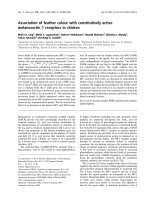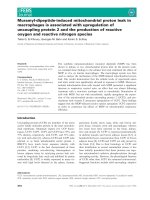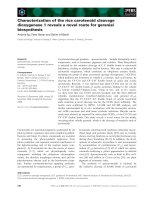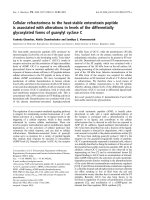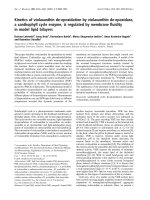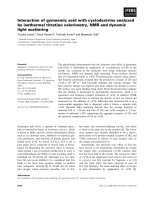Báo cáo khoa học: "Advantage of vacuum assisted closure on healing of wound associated with omentoplasty after abdominoperineal excision: a case report" pdf
Bạn đang xem bản rút gọn của tài liệu. Xem và tải ngay bản đầy đủ của tài liệu tại đây (357.13 KB, 5 trang )
BioMed Central
Page 1 of 5
(page number not for citation purposes)
World Journal of Surgical Oncology
Open Access
Case report
Advantage of vacuum assisted closure on healing of wound
associated with omentoplasty after abdominoperineal excision: a
case report
Silvia Cresti, Mehdi Ouaïssi*, Igor Sielezneff, Jean-Baptiste Chaix,
Nicolas Pirro, Bruno Berthet, Bernard Consentino and Bernard Sastre
Address: Service de Chirurgie Digestive et Oncologique, Pôle d'Oncologie et de Spécialités Médicales et Chirurgicales, Hôpital De la Timone,
Marseille, France
Email: Silvia Cresti - ; Mehdi Ouaïssi* - ; Igor Sielezneff -
hm.fr; Jean-Baptiste Chaix - ; Nicolas Pirro - ;
Bruno Berthet - ; Bernard Consentino - ; Bernard Sastre -
hm.fr
* Corresponding author
Abstract
Background: Primary closure of the perineum with drainage after abdominoperineal excision of
the rectum for carcinoma, is widely accepted. However hematoma, perineal abscess and re-
operation are significantly more frequent after primary closure than after packing of the perineal
cavity. Those complications are frequently related to the patients' clinical antecedent (i.e
radiotherapy, diabetes, smoking).
Case presentation: In the present report, vacuum assisted drainage was used after
abdominoperineal excision for carcinoma in the very first step due to intraoperative gross septic
contamination during tumor resection. The first case: A 57-years old man with a 30-years history
of peri-anal Crohn's disease, the adenocarcinoma of the lowest part of the rectum and Crohn
colitis with multiple area of severe dysplasia required panproctocolectomy with a perineal
resection. The VAC system was used during 12 days (changed every 3 days). We observed
complete healing 18 days after surgery. The second case: A 51-year-old man, with AIDS. An
abdominoperineal resection was performed for recurrence epidermoid anal cancer. The patient
was discharged at day 25 and complete healing was achieved 30 days later after surgery.
Conclusion: The satisfactory results showed in the present report appear to be favored by
association of omentoplasty and VAC system. Those findings led us to favor VAC system in the
case of pelvic exenteration associated with high risk of infection.
Background
Primary closure of the perineum with drainage after
abdominoperineal resection (APR) of the rectum for car-
cinoma, is widely accepted [1]. Meticulous hemostasis
and avoidance of intra-operative gross septic contamina-
tion are mandatory. However hematoma, perineal abscess
and reoperation are significantly more frequent after pri-
mary closure than after packing of the perineal cavity[1].
Published: 23 December 2008
World Journal of Surgical Oncology 2008, 6:136 doi:10.1186/1477-7819-6-136
Received: 6 July 2008
Accepted: 23 December 2008
This article is available from: />© 2008 Cresti et al; licensee BioMed Central Ltd.
This is an Open Access article distributed under the terms of the Creative Commons Attribution License ( />),
which permits unrestricted use, distribution, and reproduction in any medium, provided the original work is properly cited.
World Journal of Surgical Oncology 2008, 6:136 />Page 2 of 5
(page number not for citation purposes)
Those complications are frequently related to the patients'
clinical antecedent (i.e. radiotherapy, diabetes, smoking)
[2-4]. Thus, failure of perineal wound healing after aden-
ocarcinoma of the lower rectum is a major problem in
colorectal surgery. It prolongs hospitalization and may
delay or even preclude adjuvant radiochemotherapy with
a direct impact on local recurrence and long-term survival
[5]. In our experience as Debroux study's, we usually use
transposition of great omentum in APR with excellent pri-
mary perineal wound healing [6]. Vacuum Assisted-Clo-
sure (VAC
®
: KCI Kinetic Concept Inc, San Antonio, Texas)
device decreases the time of wound healing, thus increas-
ing the deposition of granulation tissue [7]. Thus, we
decided to replace dressing by VAC
®
. We report, for the
first time, safety of this management in order to improve
and reduce the long stay of hospitalization as well as the
development of chronic perineal sinus. This first prelimi-
nary observation of wound dehiscence management after
APR using transposition of greater omentum and VAC to
be extended in a large scale requires a prospective study.
Moreover, such study may allow to investigate the possi-
ble benefit of the method we have described in the present
report to increased angiogenesis.
Case presentation
Case 1
A 57-years old man with a 30-years history of perianal
Crohn's disease, reported, after a long lasting treatment of
his perianal disease recurrence, changes in symptoms such
as bleeding per rectum with tenesmous. Instrumental
examination (coloscopy and total body computed tomog-
raphy) found an anal verge tumor of 1,5 cm size and a
severe chronic colitis (Crohn's colitis). Staging of mag-
netic resonance imaging (MRI) was T2N0 and confirmed
by ultrasonographic endoscopy. A computed tomography
scan of the chest and abdomen was normal. Adenocarci-
noma of the lowest part of the rectum and multiple area
with severe dysplasia were assessed by pathological exam-
ination. For the first case, panproctocolectomy combined
with perineal resection was indicated for the development
of malignancy and synchronous multiple area of dyspla-
sia in the background of chronic severe colitis. The rectum
was removed according to TME (total mesorectum exci-
sion) principles [8]. The omentum was divided and deliv-
ered to the pelvic cavity and the pelvic peritoneum was
closed through the abdomen (Figure 1). Septic contami-
nation occurred by leakage of fecal material from the anus
during the perineal dissection. Moreover, there was a peri-
anal chronic sepsis due to Crohn'disease.
The perineal cavity was not primarily closed, but packed
with four roll gauze in order to ensure the perinaeal
hemostasis prior to put VAC
®
in place. The pack was
removed one day later and the VAC
®
was settled in place
(the wound measured 10 cm × 10 cm) under general
anesthesia and set at 100 mmHg depression (Type of
foam was V.A.C.
®
GranuFoam
®
Medium Dressing Kit).
Suction was chosen in function of perineal pain. The pres-
sure of suction was applied in the absence of perineal
pain. The VAC
®
was changed every 72 hours by nurses
under local anesthesia. Twelve days later, a significant
reduction of the wound size (4 cm × 6 cm) was evident
and the VAC
®
procedure was stopped. Amount of fluid
was 300 cc every day during five days and decreased to
200 cc during 3 days and 30 cc during the last two days.
The patient had a remarkable recovery and was discharged
at day 13th after surgery. The second treatment was made
by the nurse and consisted of sterile alginate dressings-
Algosteril (Brothier Laboratories) every day during five
days. A complete healing was achieved within 18 days
after surgery
Pathologic examination showed a rectal adenocarcinoma,
staged pT3 N1 M0 R0 with complete mesorectal excision
and 2 mm of circumferential resection margin. These
results led to the onset of an adjuvant systemic therapy
including radiotherapy (45 Gy) and chemotherapy (Leu-
covorin-5 FU). Radiotherapy was conducted due to the T3
local invasion and invaded nodes as well as septic con-
tamination.
Case 2
A 51-year-old man, with AIDS, previously treated for
Hodgkin's disease, developed a local recurrence six years
after the treatment of an anal epidermoid cancer, initially
managed by chemoradiation therapy (60 Gy and 5-fluor-
ouracil and mitomycin C) one year before. He was classi-
fied stage IV according to WHO (World Health
Organization clinical staging), and staging C following
the Center for disease control (CDC) classification. The
CD4 cell count was 190 cells/μl. Patient was treated by sta-
vudine (anti-retroviral drug) more than 5 years. Recur-
rence of anal epidermoid cancer was staged in MRI T4N+.
There was no distant metastase in thoraco-abdominal
computed tomography. An abdominoperineal resection
was conducted. The great omentum was pediculized on
the left gastroepiplooic artery and tightly sewn to the sub-
cutaneous fatty tissue of the perianeal skin. The perineum
was not closed primarily, but packed with three roll
gauzes. Septic contamination occurred by leakage of fecal
material from the anus during the perineal dissection.
One day after surgery, the pack was removed and the VAC
®
system was left in place under general anesthesia (the
wound measured 20 cm × 17 cm) and set at 125 mmHg
suction (figure 2). As in the case described above, suction
was chosen in function of perineal pain. The pressure of
suction was applied in the absence of perineal pain. Type
of foam was V.A.C.
®
GranuFoam
®
Medium Dressing Kit.
The VAC
®
was changed every 48 hours by nurses under
World Journal of Surgical Oncology 2008, 6:136 />Page 3 of 5
(page number not for citation purposes)
local anesthesia. The amount of fluid was 500 cc every day
during fifteen days and decreased to 400 cc during 5 days
and 100 cc during the last three days. We have experienced
the tight of dressing wound to be difficult when the
amount of count fluid reached values near 500 cc. There-
fore, we have shortened the VAC change period to 48 h.
Twenty days later, a significant reduction of the wound
(12 cm × 9 cm) was observed. The stage of the tumor was
pT3N0M0 R0. A survey without adjuvant chemotherapy
was applied. The patient was discharged at day 25 and
complete healing was achieved 30 days later. The second
treatment was made by the nurse and consisted of sterile
alginate dressings-Algosteril (Brothier Laboratories) every
day during five days.
Discussion
Failure of perineal wound healing after adenocarcinoma
of the lower rectum is a major problem in colorectal sur-
gery. It prolongs hospitalization and may delay or even
preclude adjuvant radiochemotherapy with a direct
impact on local recurrence and long-term survival [5].
Various surgical options have been reported to manage
the perineal wound after abdomino-perineal rectal resec-
tion: 1-closure with drainage; 2-reconstruction with plas-
tic surgery; 3-packing [2-4].
In Delalande'report, patients with sepsis contamination
or unsatisfactory hemostasis were enrolled in randomized
study[1]. Primary closure was associated with a signifi-
cantly higher rate of healed perineums at one month (30
A: Pedicled omentum is sutured to the subcutaneous fatty tissue with slowly absorbable interrupted suturesFigure 1
A: Pedicled omentum is sutured to the subcutaneous fatty tissue with slowly absorbable interrupted sutures.
B: Vacuum-assisted closure system C: Suction apparatus D: Perineal wound after 3 days of VAC
®
treatment at 100 mmHg.
Note the contracted wound with healthy granulation tissue. F: Perineal wound after 10 days of VAC
®
treatment at 100 mmHg.
Note the contracted wound with healthy granulation tissue.
World Journal of Surgical Oncology 2008, 6:136 />Page 4 of 5
(page number not for citation purposes)
percent vs. 0 percent; P = 0.01) and a shorter delay to com-
plete cicatrization (median, 47 vs. 69 days) (P < 0.01).
Conversely, hematoma, perineal abscess, and re-opera-
tions were significantly more frequent (P < 0.01) in the
primary closure group[1]. Delande's study was used as a
reference in packing since it represents the unique rand-
omized study including sufficient number of patients and
having conducted packing and primary wound in patients
with sepsis contamination or unsatisfactory haemostasis
[1].
Moreover, the reconstruction by well vascularized tissue
in large pelvic exenteration had the same risk of disunion
or wound abscess of expert Team and are represented by
patients with pelvic exenteration and septic contamina-
tion[9]. According to Butler's recent retrospective study,
VRAM flap reconstruction of irradiated APR defects
reduces major perineal wound complications without
increasing early abdominal wall complications[10]. To
our knowledge, there is no randomized study which com-
pared the reconstruction of well vascularized bulky tissue
between packing or wound closure in patients with sepsis
contamination or unsatisfactory hemostasis. Thus, in spe-
cific situation (i.e. radiotherapy, sepsis contamination or
pelvic exenteration) we preferred used the physiologic
properties of the omentum and not to conduct primary
closure.
As in Debroux's study we usually use transposition of
great omentum in APR with excellent primary perineal
wound healing[6]. According to Christian study's patients
with anal cancer and inflammatory bowel disease were at
higher risk for perineal wound complications than those
with rectal cancer. Vacuum assisted closure may be suc-
cessfully used after complex perineal wound (such as
Fournier's gangrene) or after persistent perineal
sinus[11,7]. The Vacuum-assisted closure device decreases
the time of wound healing, thus increasing the deposition
of granulation tissue [7]. In the present study, we reported
for the first time the dressing replacement by VAC which
might be an interesting approach leading to decrease hos-
pitalization duration and reduction of chronic perineal
sinus development.
Several factors led us to use VAC therapy in the present
reported cases:
- A safe and dry dressing is difficult to achieve after pack-
ing (Mickulicz) [7];
- The presacral space left after rectal excision enables accu-
mulation of blood and effusion enhancing therefore the
potential risk of wound infection [7];
- Patients' antecedent (Crohn's disease) or immunodefi-
ciency (HIV) potentially increased the wound infection
risk that might interfere with perineal closure.
- Avoidance of chronic sinus due to wide abdomino-peri-
neal resection [12].
Moreover, during VAC therapy a significant change in bac-
terial local flora (decrease number of non fermentative
bacteria) and diminution of bacteria count were observed
[13,14]. These findings appear to favor healing and might
shorten the length of the hospitalization stay.
In the De Broux's study healing was not defined[6]. A
number of studies have reported the rate of abscess, disun-
ion, or event which delayed healing. However, the cicatri-
zation evolution was not defined. According to De Broux's
study[6], the length of hospitalization stay was 20 ± 9
days, and this value is comparable to that observed in the
present report (18, 25 days). Moreover, due to the fact that
it is a new management of abdomino perineal resection
study we decided to have a complete healing for the hos-
A: Perineal wound after 3 days of VAC
®
continuous treatment at 125 mmHgFigure 2
A: Perineal wound after 3 days of VAC
®
continuous treatment at 125 mmHg. B: Perineal wound after 8 days of
VAC
®
continuous treatment at 125 mmHg. Note the contracted wound with healthy granulation tissue C: Perineal wound
after 12 days of VAC
®
continuous treatment at 125 mmHg. Note the contracted wound with healthy granulation tissue.
Publish with BioMed Central and every
scientist can read your work free of charge
"BioMed Central will be the most significant development for
disseminating the results of biomedical research in our lifetime."
Sir Paul Nurse, Cancer Research UK
Your research papers will be:
available free of charge to the entire biomedical community
peer reviewed and published immediately upon acceptance
cited in PubMed and archived on PubMed Central
yours — you keep the copyright
Submit your manuscript here:
/>BioMedcentral
World Journal of Surgical Oncology 2008, 6:136 />Page 5 of 5
(page number not for citation purposes)
pital discharge. The second treatment was made by the
nurse and consisted of sterile alginate dressings-Algosteril
(Brothier Laboratories) every day during five days after
discharge for the two patients. In view of the data, the
management of the large tissue defects in pelvic regions by
means of VAC as a temporary coverage positively supports
wound conditioning, reduces infectious complications,
and facilitates a definitive wound closure [14]. The effi-
cacy of VAC
®
in pelvic resection in cirrhotic patient [15]
was confirmed by Stawicky et al. Thus, Vacuum-based
therapy appears to be safe, effective, and convenient to the
patient and nursing staff, and allows for less frequent
dressing changes and better quantification of fluid loss
from the wound [15].
Conclusion
Although our preliminary observations are related to two
patients, it is likely that the association of omentoplasty
and VAC system is the key factor leading to the satisfactory
results reported in the present study. These findings led us
to favor VAC system in case of pelvic exenteration associ-
ated with high risk of infection.
Consent
Written informed consent was obtained from the patients
for publication of this case report and accompanying
images. A copy of the written consent is available for
review by the Editor-in-Chief of this journal.
Competing interests
The authors declare that they have no competing interests.
Authors' contributions
SC was involved in study concept and design, acquisition
of data, analysis and interpretation of data, and drafting of
manuscript. MO was involved in study concept and
design, acquisition of data, analysis and interpretation of
data, and critical revision of manuscript, study supervi-
sion. IS was involved in study concept and design, analy-
sis and interpretation of data, and critical revision of
manuscript. JC was involved in acquisition of data. NP
was involved in the drafting of manuscript. BB was
involved in critical revision of manuscript.
BC was involved in critical revision of manuscript. BS was
involved in study concept and design, drafting of manu-
script and its critical revision for important intellectual
content with over all study supervision.
Acknowledgements
This work was supported by Assistance Publique des Hôpitaux de Marseille
and Faculté de Médecine de Marseille.
References
1. Delalande JP, Hay JM, Fingerhut A, Kohlmann G, Paquet JC: Perineal
wound management after abdominoperineal rectal excision
for carcinoma with unsatisfactory hemostasis or gross septic
contamination: primary closure vs. packing. A multicenter,
controlled trial. French Association for Surgical Research.
Dis Colon Rectum 1994, 37:890-896.
2. Bullard KM, Trudel JL, Baxter NN, Rothenberger DA: Primary peri-
neal wound closure after preoperative radiotherapy and
abdominoperineal resection has a high incidence of wound
failure. Dis Colon Rectum 2005, 48:438-443.
3. Chessin DB, Hartley J, Cohen AM, Mazumdar M, Cordeiro P, Disa J,
Mehrara B, Minsky BD, Paty P, Weiser M, Wong WD, Guillem JG:
Rectus flap reconstruction decreases perineal wound com-
plications after pelvic chemoradiation and surgery: a cohort
study. Ann Surg Oncol 2005, 12:104-110.
4. Christian CK, Kwaan MR, Betensky RA, Breen EM, Zinner MJ, Bleday
R: Risk factors for perineal wound complications following
abdominoperineal resection. Dis Colon Rectum 2005, 48:43-48.
5. Rothenberger DA, Wong WD: Abdominoperineal resection for
adenocarcinoma of the low rectum. World J Surg 1992,
16:478-485.
6. De Broux E, Parc Y, Rondelli F, Dehni N, Tiret E, Parc R: Sutured
perineal omentoplasty after abdominoperineal resection for
adenocarcinoma of the lower rectum. Dis Colon Rectum 2005,
48:476-481.
7. Schaffzin DM, Douglas JM, Stahl TJ, Smith LE: Vacuum-assisted clo-
sure of complex perineal wounds. Dis Colon Rectum 2004,
47:1745-1748.
8. Heald RJ: Rectal cancer: the surgical options. Eur J Cancer 1995,
31A:1189-1192.
9. Khoo AK, Skibber JM, Nabawi AS, Gurlek A, Youssef AA, Wang B,
Robb GL, Miller MJ: Indications for immediate tissue transfer
for soft tissue reconstruction in visceral pelvic surgery. Sur-
gery 2001, 130:463-469.
10. Butler CE, Gundeslioglu AO, Rodriguez-Bigas MA: Outcomes of
immediate vertical rectus abdominis myocutaneous flap
reconstruction for irradiated abdominoperineal resection
defects. J Am Coll Surg
2008, 206:694-703.
11. Yousaf M, Witherow A, Gardiner KR, Gilliland R: Use of vacuum-
assisted closure for healing of a persistent perineal sinus fol-
lowing panproctocolectomy: report of a case. Dis Colon Rectum
2004, 47:1403-1407.
12. Pemberton JH: How to treat the persistent perineal sinus after
rectal excision. Colorectal Dis 2003, 5:486-489.
13. Moues CM, Vos MC, Bemd GJ van den, Stijnen T, Hovius SE: Bacte-
rial load in relation to vacuum-assisted closure wound ther-
apy: a prospective randomized trial. Wound Repair Regen 2004,
12:11-17.
14. Mullner T, Mrkonjic L, Kwasny O, Vecsei V: The use of negative
pressure to promote the healing of tissue defects: a clinical
trial using the vacuum sealing technique. Br J Plast Surg 1997,
50:194-199.
15. Stawicki SP, Schwarz NS, Schrag SP, Lukaszczyk JJ, Schadt ME, Dip-
polito A: Application of vacuum-assisted therapy in postoper-
ative ascitic fluid leaks: an integral part of multimodality
wound management in cirrhotic patients. J Burns Wounds 2007,
6:e7.

